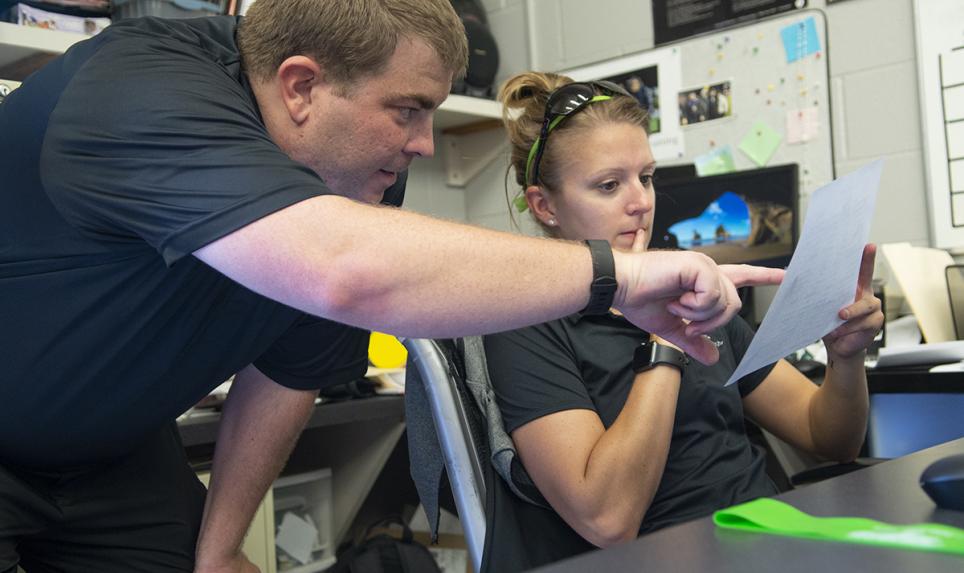Athletic trainers are unique health care professionals who work with patients through the full continuum of care. Athletic trainers help to implement preventative measures such as preparticipation physical examinations, injury trend analysis, weather monitoring and thorough facility and equipment inspection before use with the goal of mitigating risk to the athlete.
While emergencies, natural disasters and catastrophic injuries are rare, they can occur at any time and athletic trainers must always be prepared to act. Their education and clinical training make athletic trainers experts in both injury prevention and wellness protection and immediate and emergency care. This knowledge and skill set makes athletic trainers an integral part of any school’s athletic health care team. Schools that employ full time athletic trainers reap the benefits of the athletic trainers’ ability to mitigate the risk of injuries, prepare for emergencies, and provide immediate care for things like concussions, heat stroke, spine injuries, asthma attacks and sudden cardiac arrest.
An emergency action plan (EAP) is a cornerstone in an athletic trainer’s emergency preparedness. Simply put, an EAP outlines who needs to do what and when in an emergency situation. More precisely, an EAP is a venue specific plan that describes the involved personnel and their roles in an emergency, the communication process and necessary information, emergency equipment location and transportation pickup locations and response times.
Athletic trainers play an important role in the development, rehearsal and implementation of the EAP. The athletic health care team (which includes the athletic trainer, team physician athletic director, coaches, facility manager and school nurse) must consider the potential catastrophic events in sports and plan for how they will respond to each. This preparation requires attention to detail, organization, collaboration and a comprehensive understanding of the potential risks that their athletes might face.
In preparing for sudden cardiac arrest in sport, athletic trainers work collaboratively with the school athletic director, coaches and other personnel to ensure that there are clear response instructions, that the automated external defibrillator (AED) is located within 1 to 3 minutes of the venue and in working order, and that appropriate staff are CPR trained and ready to act. It is the athletic trainer’s role to ensure that these plans are in place and rehearsed before an athletic event. Athletic trainers must continually review these plans and make necessary adjustments, taking into consideration things like construction at the school that may alter emergency services access and changes in contact information.
Team physicians and athletic trainers are the most likely medical professionals to be on site during a catastrophic event. Their insights to these situations provide critical information for emergency readiness for the entire sports medicine field and the athletes that they serve. By reporting details of the event, athletic trainers and other sports medicine professionals are able to improve the management of future catastrophic or near death events through the development of better preventative policies. Indeed, athletic training is one of the few public health and health care professions that lists prevention as a main responsibility.1
Ultimately, it is the responsibility of the organization who sponsors athletic activities to develop an EAP that can be implemented immediately and appropriately.2 Athletic trainers play a critical part in the development, rehearsal and implementation of these plans, yet research shows that only 34% of schools have access to a full time athletic trainer.3 If your school doesn’t have an athletic trainer, ask questions and discuss with your school how you can provide a safer approach for your student athletes through the employment of an athletic trainer.
References:
- Thomas P. Dompier, Kristen L. Kucera, Jonathan Drezner, Douglas J. Casa, Johna Register-Mihalik, and Kevin M. Guskiewicz (2019) Sudden Death and Catastrophic Injury Reporting: A Call to Action for Athletic Trainers. Journal of Athletic Training In-Press. https://doi.org/10.4085/1062-6050-77-18
- R.C Anderson, Ronald W. Courson, Douglas M. Kleiner, Todd A. McLoda. National Athletic Trainers’ Association Position Statement: Emergency Planning in Athletics. Journal of Athletic Training.2002;37(1):99–104.https://www.nata.org/sites/default/files/EmergencyPlanningInAthletics.pdf
- KSI ATLAS 2018 Reporthttps://ksi.uconn.edu/nata-atlas/atlas-report/
